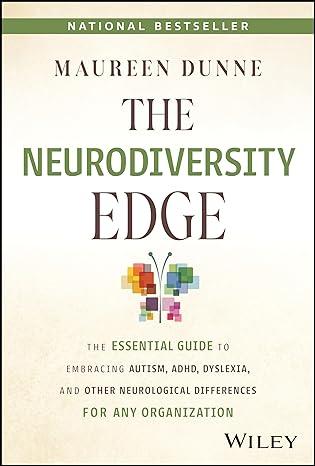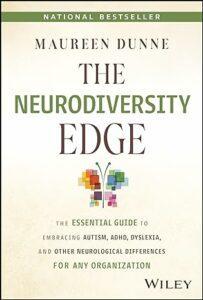The Neurodiversity Edge
The Essential Guide to Embrace Autism, ADHD, Dyslexia and Other Neurological Differences for Any Organization


Dr Maureen Dunne is a cognitive scientist. She gained her PhD from Oxford University in Cognitive and Learning Sciences, where she was a Rhodes Scholar. She currently serves as the neurodiversity expert for the LEGO Foundation’s $20 million Play For All global accelerator social impact fund targeting neurodiversity inclusion. She is also the co-founder of the first neurodiversity social impact investment association and the CEO of Autism Community Ventures, a neurodiversity inclusion consultancy and social impact firm.
She has served as a senior advisor to some of the world’s top brands, Fortune 500 companies, higher education institutions and government officials – helping organizations build thriving cultures for more than two decades.
We live in a world where for the last 200 years everything commercial has been adapted and shaped to conform to the most efficient process. It has been a recipe for extraordinary success, with leaps and bounds in technical and mechanical and electronic productivity. The irony is that many of the great ‘breakthroughs’ have been achieved by mavericks, people who did not conform with the existing business world and only got ‘heard’ when they had created something extraordinary on their own. Thomas Edison is one such, that many now think suffered from ADHD. Richard Branson famously failed to achieve any public exams, due to his dyslexia, and has subsequently been diagnosed as having ADHD too.
Maureen Dunne asks at the beginning of this very readable book “how can neurodivergent people be responsible for a disproportionate share of our important innovations while most are so strikingly left out of the economy or on the margins of society?”
Things are definitely improving – both in the recognition of neurodivergent behaviours, it was not so long ago that dyslexia was not even recognized as a real issue, and in the benefits that neurodivergency can bring to organizations. But nonetheless, in a 2020 survey of UK employers, Dunne notes that “50% openly admitted that they would not hire a neurodivergent job seeker”.
Part of the issue is that the spectrum we identify neurodivergency on is so wide that that many people are not confident on how to react to it. Where do we place those with ADHD, dyslexia, dyspraxia, dyscalculia, dysgraphia, misophonia, stammering… we know that having any of these conditions is entirely independent from your intelligence. Some with these conditions will be brilliant, others less so – just like almongst the neurotypical.
Neurodiversity, as Dunne describes, just means those who think in a different way to the majority. The majority being termed ‘neurotypical’. The crucial concept being that being neurotypical is neither better nor worse than being neurodivergent for many; it is just probably easier, as being part of the mainstream is usually a less challenging existence than being part of the periphery. The world tends to be shaped for the mainstream and those who do not fit that, have to adapt to work with it.
This book is both a call for organizations to accommodate neurodiversity – as much, if not more, for their own benefit as for the neurodiverse – and a guide on how they can do that.
We live in a world that likes to think in linear terms. Dunne opens the book with a quote from Edwin Abbot’s 1884 book Flatland, that tries to describe to people who see the world in two-dimensions, what the third dimension can offer them – and this is the richness that she explains we are missing out on, by only looking at problems, processes and people in a singular way of thinking, that of the neurotypical. How much are we missing by not embracing alternative ways of viewing issues?
The case against groupthink and in favour of different ways of thinking – be they lateral thinking, hyperfocus, visual thinking, dyslexic thinking, pattern thinking, bottom-up thinking, reverse engineering or many others, is easy enough to set-out, and Dunne does so clearly and compellingly.
The challenge is in the ‘How do we enable this’ part, that makes up two-thirds of the book. And as with just about every organizational challenge, the answer lies not in some clever technical solution or innovation, or even some new framework – but in ages-old human behaviours. It is about culture and mindset.
At the heart of the book lies Dunne’s 5-step Pyramid of Neuroinclusion. She describes it as: “…a layered set of objectives that…must all be cemented into place to bring about lasting authentic neuroinclusion…“
The five layers are: ‘trust and psychological safety’; ‘transparent communications’; ‘universal design principles at work’; ‘auxiliary support accessibility’; ‘universal empathy’ leading to ‘authentic neurodiversity inclusion’.
Dunne weaves these approaches through the remainder of the book. There is an important chapter on ‘Recruiting for Diversity’ that sets out the strategies needed to be borne in mind to do this well. And more closely on the layers themselves, one – close to Ideas for Leaders hearts – on ‘Accommodating Humans’, which recognizes that everyone is different, and that what fits many doesn’t fit all. This is part of Universal Design, and its Seven Principles. And another on ‘Workplace Flexibility’ which deals with auxiliary support flexibility. And the last of the sections on universal empathy.
Dunne’s conclusion on why neurodiversity is so important today, is well worth reflecting on. We live in ‘the transformation age’ where change occurs at increasing velocity, and it is far harder to describe what the world will look like a decade ahead, than it has ever been before. This is principally driven by technological advances, with today’s focus on AI and AGI.
AGI, as we currently can predict it, still works on a linear basis of data curation. In order for us to come up with the truly revolutionary new ideas, rather than the incrementally improved ones, we will still need out-of-the-box thinking, and that tends to come from non-linear thought. As Dunne puts it an AI trained on baroque music of Bach, Handel and Corelli could generate new pieces, but they would be largely indistinguishable from the pieces they learnt from – there would be no Moonlight Sonata. If we are to create future Moonlight Sonatas in a wide range of subject areas, we will need greater cognitive diversity. As she says, embracing “authentic neurodiversity as a core organizational value… is not the whole solution to anything, but it is part of the solution to nearly everything.”
Organizations need to structure themselves in such a way that they can leverage this talent. In such a way that they are embracing cognitive diversity and making those who can bring it to their organizations be transparently valued and comfortable to be doing so.

Title: The Neurodiversity Edge: the essential guide to embracing autism, ADHD, dyslexia and other neurological difference for any organization
Author/s Name/s: Maureen Dunne
Publisher: John Wiley & Sons
ISBN: 978-1-394-199-280
Publishing Date: March, 2024
Number of Pages: 279